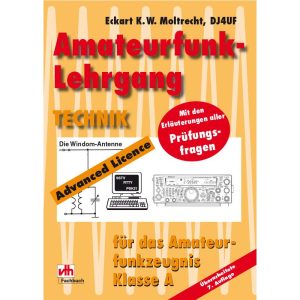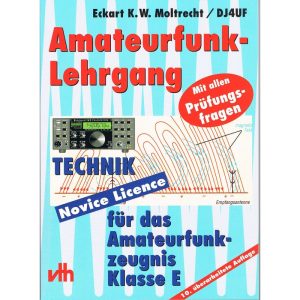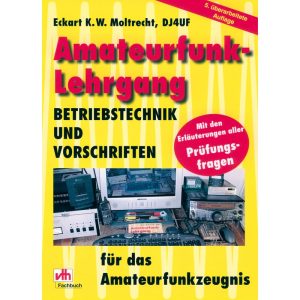In order to be allowed to radio worldwide yourself, you need a solid technical and operational training. This is provided by various clubs and groups of radio amateurs in courses. The goal of the courses is to successfully pass the exam and obtain the certificate of proficiency as HB3 or HB9 operator. You can pass the exam regardless of your age and professional orientation. In Switzerland, the Federal Office of Communications OFCOM examines applicants for an amateur radio license in technical and operational subjects.
How to become a radio amateur? |
||||||||||||||||||
1 |
Interested?Go snooping at an amateur radio club event, ask questions and make contacts.
|
|||||||||||||||||
2 |
Start training
For the training a period of 6-12 months and a budget of about 500-1000 CHF (course, documents, exam, license) should be foreseen.
|
|||||||||||||||||
3 |
Training of the exam tasksStudy of exam tasks, regulations, and course materials or literature. Information: Question catalog for the exam Clarify questions in the course or with radio amateurs |
|||||||||||||||||
4 |
Practice with a club or radio amateurSome practice “how to make a QSO” is important. In the section, club, with a godfather such practice days can be inserted. Many clubs also offer to participate in a contest for practice. Training sections and clubs have the license of the BAKOM “General Speaker Permit” in the presence of a HB9 radio amateur. |
|||||||||||||||||
5 |
Registration for the examList of exam dates amateurs The registration takes place here: www.eofcom.admin.ch
|
|||||||||||||||||
6 |
Examination at the BAKOMin Biel or at the course provider (exam result will be announced immediately).
|
|||||||||||||||||
7 |
FähigkeitszeugnisIf the test is passed: OFCOM sends the license (1-2 weeks)
|
|||||||||||||||||
8 |
Allocation of the call signAfter receiving the license: Apply to OFCOM for a call sign (1-2 weeks). The allocation request can be filled out online at: |
|||||||||||||||||
9 |
You are now a radio amateur!After receipt of the email or upon inspection on the OFCOM page, the callsign is visible.
|
|||||||||||||||||
What needs to be done after the amateur radio exam?
- Buying a radio: The easiest way to radio is to use a handheld radio. Cheap handheld radios cost 100.- cheap with few possibilities 200.- something right there is new not under 300.-; Disadvantage is however that in the normal case only 2m and 70 cm can be worked.
But there is also the possibility to buy portable or stationary devices. Here, depending on the device, shortwave operation is possible. - Create logbook: To keep track of the worked countries, it is recommended to create a logbook. Furthermore, the logbook is used to manage the QSL cards that are received and sent.
Computer programs can be used as a logbook, which can also be connected to the transceiver. For example, it is possible to automatically rotate the rotor of directional antennas or to automatically transfer the radio frequency to the logbook.
It is also possible to use a classic booklet for entering the radio partners. - Design QSL card: Radio amateurs usually confirm first-time QSOs with QSL cards. These cards are similar to postcards. A picture is printed on the front. The back contains data from the radio call, such as the frequency, time, etc. QSL cards are used by the radio amateur as a proof of having radioed with a station.
Nowadays it is also possible to send QSL cards via special websites. For example, these are LotW or eQSL.
However, many radio amateurs still prefer paper cards and use the electronic services only additionally. https://www.qsl-shop.com/ is good and cheap. You get help with the layout and get the good for printing, even several times.
USKA members get a 20% discount when ordering QSL cards from www.qslshop.de. More information: DARC QSL Service (pdf) - Registration on QRZ.com: Many radio amateurs use the database QRZ.com during radio operation to complete their own logbook. A registration on www.qrz.com is therefore recommended.
- Joining the USKA: Joining the USKA is very useful and has many advantages. Members receive the QSL cards of the QSO partners via the QSL service. For more information, see Membership in the USKA.
Training to become a radio amateur: course locations, dates and contact details
Training courses HB3 (CEPT Novice Licence) - the 'Beginner Class' and HB9 (CEPT Licence) - the 'Grand Licence Class'
New dates or changed dates? >>> eMail to webmaster@uska.ch
| Termin | Zeit | Kategorie | Event | |||
| toute l année | - |
 Outlook Outlook iCal iCal Google Google Yahoo Yahoo
|
HB3/HB9 Kurse dauerhaft | HB9MM Formation (fr) | ||
| ganzjährig | - |
 Outlook Outlook iCal iCal Google Google Yahoo Yahoo
|
HB3/HB9 Kurse dauerhaft | DARC-Online-Lehrgang (Online) |
Morse code courses / CW / Learn telegraphy
| Termin | Zeit | Kategorie | Event | |||
| ganzjährig | - |
 Outlook Outlook iCal iCal Google Google Yahoo Yahoo
|
CW Kurse dauerhaft | DARC CW Kurs (Online) | ||
| ganzjährig | - |
 Outlook Outlook iCal iCal Google Google Yahoo Yahoo
|
CW Kurse dauerhaft | HB9HTC: MUS = Morseübungssendung und QRS QSOs bei Tempo 40 - 80 BpM, für Newcomers, Beginners | ||
| Tutto l anno | - |
 Outlook Outlook iCal iCal Google Google Yahoo Yahoo
|
CW Kurse dauerhaft | Tera Radio Club via HB9EDG - CW Formazione (it) | ||
| ganzjährig | - |
 Outlook Outlook iCal iCal Google Google Yahoo Yahoo
|
CW Kurse dauerhaft | Tera Radio Club via HB9EDG - CW Kurs (de) | ||
| ganzjährig | - |
 Outlook Outlook iCal iCal Google Google Yahoo Yahoo
|
CW Kurse dauerhaft | Telegrafiekurs von DL8MH (deutsch) auf YouTube |
USKA Academy & Thematic Courses
| Termin | Zeit | Kategorie | Event | |||
| 26.10.24 | 8:30 - 16:00 |
 Outlook Outlook iCal iCal Google Google Yahoo Yahoo
|
Flohmarkt | Surplus Party - Amateurfunk Flohmarkt, Zofingen (HB9FX) |
Information about the test

On its own website, OFCOM provides information on the examinations, examination dates, registration forms, a list of course providers, examples of examination questions, dates and registration for amateur radio examinations.
Link: OFCOM amateur radio examinations (overview)
Since January 2015, certificates of competence and amateur radio licenses have been issued in credit card format. In contrast to the previous paper documents, they offer the best possible security against counterfeiting and can be easily carried in a wallet. The previous ID cards in paper format are still valid.
Link: Radio operator examinations in general
The Federal Office of Communications provides the following examples of exam questions.
Examples of examination tasks (technology)
| DE | FR | IT | |
| 2018 | BAKOM Fragenkatalog Technik (2018) De | BAKOM Fragenkatalog Technik (2018) Fr | BAKOM Fragenkatalog Technik (2018) It |
| 4/2023 | BAKOM Fragenkatalog Technik (2023) De | BAKOM Fragenkatalog Technik (2023) Fr | BAKOM Fragenkatalog Technik (2023) It |
| 10/2023 | BAKOM Fragenkatalog Technik 20.10.2023 | — | — |
| aktuell | Aktuell gibt die BAKOM keinen Fragenkatalog mehr heraus | Actuellement, l’OFCOM ne publie plus de catalogue de questions | Attualmente l’UFCOM non pubblica più un catalogo di domande. |
| Quelle: Webseite BAKOM | Quelle: Webseite BAKOM | Quelle: Webseite BAKOM |
Authorized documents for the amateur radio examinations
Only the following formulary and help sheet may be taken to the amateur radio examinations. Please print these out and take them with you to the exam, additional notes or additions are not permitted.
| DE | FR | IT | |
| 2023 (aktuell) |
BAKOM Formelsammlung Deutsch 2023 BAKOM Hilfstabellen D 2023 |
BAKOM Feuille D’aide 2023 BAKOM Recueil D’aide 2023 |
BAKOM Formulario 2023 BAKOM Foglio Di Aiuto 2023 |
| Quelle: Webseite BAKOM | Quelle: Webseite BAKOM | Quelle: Webseite BAKOM |
Examples of audit tasks (regulations)
| DE | FR | IT | |
| 2018 | BAKOM Fragenkatalog Vorschriften (2018) De | BAKOM Fragenkatalog Vorschriften (2018) Fr | BAKOM Fragenkatalog Vorschriften (2018) It |
| 2021 | BAKOM Fragenkatalog Vorschriften (2021) De | BAKOM Fragenkatalog Vorschriften (2021) Fr | BAKOM Fragenkatalog Vorschriften (2021) It |
| 8/2023 | BAKOM Fragenkatalog Vorschriften 21. 8. 2023 BAKOM Loesungen Fragenkatalog Vorschriften21. 8. 2023 |
— — |
— — |
| aktuell | Aktuell gibt die BAKOM keinen Fragenkatalog mehr heraus | Actuellement, l’OFCOM ne publie plus de catalogue de questions | Attualmente l’UFCOM non pubblica più un catalogo di domande. |
| Quelle: Webseite BAKOM | Quelle: Webseite BAKOM | Quelle: Webseite BAKOM |
Leaflet Amateur Radio
| DE | FR | IT | |
| 2021 (aktuell) |
Merkblatt Amateurfunk (2021) | Notice Concernant Les Radioamateurs (2021) | Scheda Informativa Per Radioamatori (2021) |
| Quelle: Webseite BAKOM | Quelle: Webseite BAKOM | Quelle: Webseite BAKOM |
Kostenlose Unterlagen der USKA
| Downloads | |||
|---|---|---|---|
|
Keine Download-Pakete gefunden |
|||
Free online course of the German DARC
Literatur
Amateurfunk Lehrgang Technik “Der Weg zu HB9” von E.K.W. Moltrecht, DJ4UF
Dieser Lehrgang basiert auf dem Prüfungsfragenkatalog 2007 der Bundesnetzagentur (BNetzA). Alle darin vorkommenden Themen aus den Bereichen Mathematische Grundlagen, Elektrotechnik, Elektronik sowie Sender- und Empfängertechnik, Übertragungstechnik, Antennentechnik und Messtechnik aus dem Bereich “Technische Kenntnisse” werden ausführlich erläutert. Es werden die Kenntnisse aus dem Amateurfunklehrgang für das Amateurfunkzeugnis Klasse E vorausgesetzt. Als zusätzliche Unterlage wird der aktuelle Fragenkatalog der Bundesnetzagentur (BNetzA) benötigt.
Das Buch ist so aufgebaut, dass ein didaktisch sinnvoller Lehrgang entsteht und dabei konkret auf die vorkommenden Prüfungsfragen aus dem Fragenkatalog der BnetzA eingegangen wird. Es werden die schwierigen Prüfungsaufgaben ausführlich vorgerechnet und die Prüfungsfragen beantwortet. Der Lehrgang ist gleichermaßen für die Begleitung von Amateurfunkkursen als auch für das Selbststudium geeignet.
304 Seiten, Format 16,5×23 cm
VTH-Best.-Nr. 411 0089
ISBN: 978-3-8180-389-2
Bestellung:
- https://darcverlag.de/Amateurfunklehrgang-Technik-fuer-das-Amateurfunkzeugnis-Klasse-E
- https://www.lutz-electronics.ch/fachliteratur-lernpakete-werkstatt/ausbildung-literatur/
- https://www.exlibris.ch/de/buecher-buch/deutschsprachige-buecher/eckart-k-moltrecht/amateurfunk-lehrgang-fuer-das-amateurfunkzeugnis-klasse-a/id/9783881803892
Amateurfunk Lehrgang Technik für die Einsteigerlizenz von E.K.W. Moltrecht, DJ4UF
Dieser Lehrgang basiert auf dem Prüfungsfragenkatalog für das Amateurfunkzeugnis Klasse E der Bundesnetzagentur. Alle darin vorkommenden Themen aus den Bereichen Grundlagen der Elektrotechnik, der Elektronik sowie der Sender- und Empfängertechnik, Antennentechnik und Messtechnik einschließlich der Berechnungen für die elektromagnetische Verträglichkeit werden so ausführlich erläutert, dass der Prüfling in die Lage versetzt wird, jede Frage aus dem Fragenkatalog richtig beantworten zu können.
Aus der Erfahrung von praktischen Lehrgängen wurde die Reihenfolge des Unterrichtsstoffs so gewählt, dass schon bald zu Anfang einige interessante Kapitel aus der Funktechnik gebracht werden. Dennoch werden keinerlei Vorkenntnisse aus der Elektrotechnik vorausgesetzt sondern auf dem normalen Grundschulwissen aufgebaut.
240 Seiten, Format 16,5×23 cm
VTH-Best.-Nr. 411 0064
ISBN: 978-3-88180-364-9
Bestellung:
- https://darcverlag.de/Amateurfunklehrgang-Technik-fuer-das-Amateurfunkzeugnis-Klasse-E
- https://www.lutz-electronics.ch/fachliteratur-lernpakete-werkstatt/ausbildung-literatur/
- https://www.exlibris.ch/de/buecher-buch/deutschsprachige-buecher/eckart-k-moltrecht/amateurfunk-lehrgang-fuer-das-amateurfunkzeugnis-klasse-e/id/9783881803649
Amateurfunk Lehrgang “Betriebstechnik und Vorschriften”von E.K.W. Moltrecht, DJ4UF
Sehr ausführlich und immer mit Blick auf die zugehörigen Prüfungsfragen werden aus der Betriebstechnik die Themen internationales Buchstabieralphabet, der Q-Schlüssel, Rufzeichen, Landeskenner, betriebliche Abkürzungen, IARU-Bandpläne, Betriebsabwicklung auf Kurzwelle, Betriebsabwicklung auf VHF/UHF, digitale Betriebsarten, RST-System, Logbuch, QSL-Karte besprochen.
Besonders bei den vielen zu lernenden Begriffen wie Landeskenner, Q-Gruppen oder Frequenzbereiche wurden die Übersichten gegenüber dem Fragenkatalog auf das notwendige Maß reduziert. Ferner werden die gesetzlichen Bestimmungen und Verordnungen und weitere Vorschriften, die den Amateurfunk betreffen, ausführlich besprochen und schwierige Rechtsbegriffe erläutert.
Dieses Buch ist die ideale Ergänzung zum Amateurfunklehrgang Technik für das Amateurfunkzeugnis Klasse E oder Klasse A. Es sollte parallel zur Technik bearbeitet werden, also etwa eine Lektion Technik und eine Lektion Betriebstechnik/Vorschriften.
156 Seiten, Format 16,5×23 cm
VTH-Best.-Nr. 411 0103
ISBN: 978-3-88180-803-3
Bestellung:
- https://darcverlag.de/Amateurfunklehrgang-Betriebstechnik-und-Vorschriften
- https://www.lutz-electronics.ch/fachliteratur-lernpakete-werkstatt/ausbildung-literatur/
- https://www.exlibris.ch/de/buecher-buch/deutschsprachige-buecher/eckart-k-moltrecht/amateurfunk-lehrgang/id/9783881808033
Harald Zisler: Amateurfunk
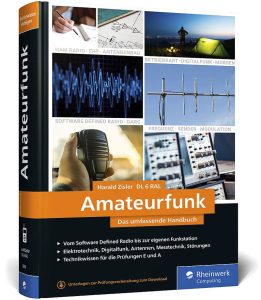 Der Amateurfunk ist ein faszinierendes Hobby: Es ist angewandte Technik und gelebte Verständigung, wenn Sie mit der selbstgebauten Antenne Kontakt zu Funkstationen in aller Welt aufnehmen. Wie das geht, zeigt Ihnen Harald Zisler (DL6RAL): Vom einfachen Einstieg bis zu den technischen Hintergründen, von Übungsfragen für die Amateurfunkprüfung bis zum Aufbau der eigenen Station. Dieses Nachschlagewerk hilft Ihnen bei den ersten Schritten und begleitet Sie in der Funkpraxis. Aus dem Inhalt: Erlebnis Amateurfunk Bauteilkunde Physikalische Grundlagen Technik des Amateurfunks Störungen & Troubleshooting Sicherheit SDR-Empfang Stationsaufbau und Antennenwahl Mobiler Funkbetrieb Digitaler Amateurfunk Morsen
Der Amateurfunk ist ein faszinierendes Hobby: Es ist angewandte Technik und gelebte Verständigung, wenn Sie mit der selbstgebauten Antenne Kontakt zu Funkstationen in aller Welt aufnehmen. Wie das geht, zeigt Ihnen Harald Zisler (DL6RAL): Vom einfachen Einstieg bis zu den technischen Hintergründen, von Übungsfragen für die Amateurfunkprüfung bis zum Aufbau der eigenen Station. Dieses Nachschlagewerk hilft Ihnen bei den ersten Schritten und begleitet Sie in der Funkpraxis. Aus dem Inhalt: Erlebnis Amateurfunk Bauteilkunde Physikalische Grundlagen Technik des Amateurfunks Störungen & Troubleshooting Sicherheit SDR-Empfang Stationsaufbau und Antennenwahl Mobiler Funkbetrieb Digitaler Amateurfunk Morsen
Technikwissen für Funkamateure – Die Inhalte der Prüfungen E und A
Inhalt: Erlebnis Amateurfunk – Amateurfunktechnik – Fachrechnen – Bauteilkunde – Physikalische Grundlagen – Die Welt der Widerstände – Elektrische Leistung – Wechselstrom/Signale – Das elektrische Feld (elektrostatisches Feld) – Magnetisches Feld und Induktivitäten – R, C und L im Wechselstromkreis – Die Halbleiterdiode – Der Transistor und seine Grundschaltungen – Die Elektronenröhre – Schaltungskunde: Stromversorgung – Grundlagen der elektronischen Schwingungserzeugung – Sende- und Empfangstechnik – Antennen – Übertragungsleitungen – Stehwellen und Leistungsrückfluss – Mantelwellen – Anpassung, Transformation und Symmetrierung – Elektromagnetisches Feld – Leistung und Feldstärke – Messung und Messgeräte – Störungen & Co. – Sicherheit – Praxis und Projekte – SDR Empfang mit SDRplay RSP2pro – Nach bestandner Prüfung – Stationsaufbau – Antennebau für Einsteiger – Funkbetrieb ausserhalb der eigenen vier Wände – Amateurfunk digital – Remote-Funkbetrieb – Morsen
687 Seiten, Format 24 x 17 x 4,5 cm
ISBN: 978-3-8362-8938-2
Bestellung:
- https://nalda.ch/products/isbn/9783836289382?country=CH
- https://www.microspot.ch/de/medien-b%C3%BCcher/sachb%C3%BCcher/natur-technik–c824500/amateurfunk–p0007954500
- https://www.galaxus.ch/de/s12/product/amateurfunk-harald-zisler-deutsch-sachbuecher-21079833
Max Rüegger HB9ACC: Praxisbuch Antennenbau
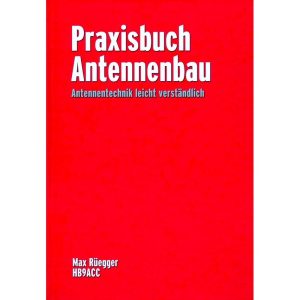 Die Antennentechnik bietet Funkamateuren selbst heute noch, wo in den Shacks kommerzielle Geräte vorherrschen, ein interessantes Betätigungs feld für den Selbstbau. In diesem Buch werden überwiegend Antennen aus Draht beschrieben, die man ohne Weiteres selbst realisieren kann.
Die Antennentechnik bietet Funkamateuren selbst heute noch, wo in den Shacks kommerzielle Geräte vorherrschen, ein interessantes Betätigungs feld für den Selbstbau. In diesem Buch werden überwiegend Antennen aus Draht beschrieben, die man ohne Weiteres selbst realisieren kann.
Dabei verzichtet der Autor bewusst auf »Kochrezepte«. Vielmehr gibt er leicht verständliche Erklärungen und vermittelt interessante Anregungen. In 40 Kapiteln mit über 600 Abbildungen und vielen Tabellen beleuchtet Max Rüegger die verschiedensten Aspekte des Baus von KW-Antennen, von der Wahl des Standorts über Speiseleitungen und Materialkunde bis hin zur Installation von Antennen – sogar solcher, die nicht sofort zu erkennen sind.
Die nunmehr vorliegende 5. Auflage wurde u.a. mit vielen nützlichen Hinweisen zu den Themen Blitzschutz und Sicherheit ergänzt.
Der Autor Max Rüegger, HB9ACC, wurde 1942 geboren und ist seit seinem 20. Lebensjahr lizenziert. Als gestandener Ingenieur der Fernmeldetechnik geht er das Thema Antennenbau von der praktischen Seite an und lässt dabei jahrzehntelange Erfahrungen aus seinem – nicht nur durch Amateurfunk geprägten – Funkerleben einfließen. Als Funkamateur bevorzugt HB9ACC die Betriebsart CW. Neben der Antennentechnik gilt sein Interesse dem DX-Verkehr, insbesondere auf den Lowbands.
488 Seiten
Folien zu den beiden Vorträgen (Antennen) von Max Rüegger, HB9ACC, bei der Sektion Bern
Ausfühliche Unterlagen zu den Vorträgen von Max Rüegger, HB9ACC (Stand: 2007)
- Rund um die Antenne, Teil 1 (pdf 3.5 MB) Allgemeines, Materialkunde, Zubehör
- Rund um die Antenne, Teil 2 (pdf 2.5 MB) Speisekabel, SWR
- Rund um die Antenne, Teil 3 (pdf 3.3 MB) Antennenkoppler, SWR-Meter, Messgeräte, Baluns
- Rund um die Antenne, Teil 4 (pdf 3.2 MB) Antennen-Theorie, Antennensimulation
- Rund um die Antenne, Teil 5 (pdf 5.5 MB) Dipole, Windom-Antennen, Trap-Antennen, Langdraht-Antennen
- Rund um die Antenne, Teil 6 (pdf 14.5 MB) Ganzwellen-Dipol, L-Antennen, Sloper, Schleifenantennen, Vertikal-Antennen
- Rund um die Antenne, Teil 7 (pdf 3.6 MB) Spannungsgespeiste Antennen, verkürzte Antennen, Sonderformen
Bestellung:
Linksammlung Start als Amateurfunker
Diese Linksammlung gibt zeigt die wichtigsten Links für den Start als Amateurfunker:
- Grundlagen, Betrieb direkt und der Relaisbetrieb Merkblatt: Der Amateurfunkverkehr über Relaisstationen: https://www.hb9uf.ch/media/Dokumente/2014_Merkblatt_Amateurfunkverkehr_ueber_Relais.pdf
- Frequenzen, Bandplan / Relais Liste
- Bandplan 70cm: https://www.uska.ch/wp-content/uploads/2022/06/20190701-IARU-R1-51-70-cm-Bandplan-V.8.50.pdf
- Bandplan 2m: https://www.uska.ch/wp-content/uploads/2022/04/20190701-IARU-R1-48-2-m-Bandplan-V.8.50.pdf
- KW Bandplan: Phttps://www.uska.ch/wp-content/uploads/2016/05/20160601_IARU_R1_HF_BANDPLAN_2016_DK4WV_v3d_color.pdf
- Frequenzliste Voice Repeater: https://www.uska.ch/wp-content/uploads/2022/06/220622-USKA_Frequenzliste_Voice.pdf
- Informationen Repeater Book: https://www.repeaterbook.com/index.php/en-us/
- QRZ.com: https://www.qrz.com/
- Programmieren von Funkgeräten, Software / Regionen:
- Übersicht der möglichen Funkgeräte und die Auswahlkriterien und Lieferanten (in der Schweiz): https://www.funktechnik-vonallmen.ch/, https://www.lutz-electronics.ch/, https://radio-laden.ch/index.html, http://www.gianora-hsu.ch/
- Zubehör und Antenne, Kabel und Stecker, Kabeldämpfung: https://koaxshop.ch
- DMR/D-Star/C4FM: https://www.swiss-artg.ch/index.php?id=23
- EchoLink in 10 Schritten zum ersten EchoLink-QSO mit dem PC: https://www.satszene.ch/hb9dww/echolink%20help/10steps.pdf
- Echolink Hilfe: https://www.satszene.ch/hb9dww/echolink%20help/help.htm
- EchoLink Portal: https://www.satszene.ch/hb9dww/echolink/portal.htm
- EchoLink Download: http://echolink.org/download.htm
- Betriebstechnik Kurzwelle: https://docplayer.org/28163530-Betriebstechnik-kurzwelle.html
- Koaxialkabel und deren Dämpfung: https://koaxshop.ch
- Logbuchprogramm
- SwissLog: https://www.swisslogforwindows.com/
- UcxLog: http://ucxlog.org/
- USKA: https://www.uska.ch
- USKA Mitgliedschaft: https://www.uska.ch/uska-mitglied-werden/
- Funken im Ausland: https://www.darc.de/der-club/referate/ausland/funken-im-ausland/
- CEPT Länder Liste: https://files.darc.de/index.php/s/CKT38kZP6miK7xf
- International Amateur Radio Union, Adressen der Verbände: https://www.iaru.org/reference/member-societies/
- BAKOM, nicht konforme Geräte Liste: https://nkgdb.ofcomnet.ch//de
- Kauf von Funkanlagen im Ausland für den Eigengebrauch: https://www.bakom.admin.ch/bakom/de/home/geraete-anlagen/merkblaetter/kauf-von-funkanlagen-im-ausland-fuer-den-eigengebrauch.html

